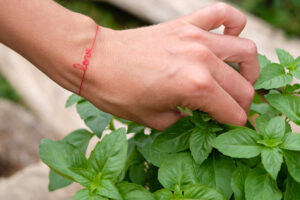Bitter Herbs: Significance, Uses, and Biblical Importance Bitter herbs have a rich history and hold significant cultural, culinary, and medicinal importance. From their crucial role in Passover traditions to their mention in the Bible, these herbs are revered for their distinctive flavors and health benefits. This article delves into what bitter herbs are, their […]
How to Harvest Basil
How to Harvest Basil: A Complete Guide for Thriving Plants
Basil is a beloved herb known for its aromatic leaves and versatile uses in various culinary dishes. Proper harvesting techniques are essential to ensure your basil plant remains healthy and continues to produce leaves throughout the growing season. In this comprehensive guide, we will cover how to harvest basil without killing the plant and how to harvest basil so it keeps growing. Additionally, we will review some tools that can make the process easier and more efficient.
Understanding Basil Growth
Before delving into harvesting methods, it’s important to understand how basil grows. Basil plants thrive in warm climates and can reach up to 24 inches in height. They grow leaves in pairs along the stem, and new growth emerges from the top. Understanding this growth pattern is key to effective harvesting.
When to Harvest Basil
The ideal time to start harvesting basil is when the plant has at least six to eight leaves, typically around six weeks after planting. Harvesting in the morning is best as the leaves are freshest. Avoid harvesting during the hottest part of the day to prevent wilting.
Tools Needed for Harvesting Basil
Using the right tools can make a significant difference in the health and productivity of your basil plant. Here are some tools that can help:
- Sharp Scissors or Pruning Shears: Essential for making clean cuts that do not damage the plant.
- Herb Stripper: Useful for quickly removing leaves from stems.
- Harvesting Basket: A container to collect the harvested leaves without crushing them.
Tool Reviews
1. Fiskars Softouch Micro-Tip Pruning Snip The Fiskars Softouch Micro-Tip Pruning Snip is an excellent tool for harvesting basil. Its sharp blades ensure clean cuts, which are crucial for promoting healthy regrowth. The soft-touch handle provides comfort during prolonged use.
Pros:
- Sharp, precise blades
- Comfortable handle
- Easy to clean
Cons:
- May be too small for larger hands
2. Chef’n LooseLeaf Kale, Chard, Collard Greens and Herb Stripper The Chef’n LooseLeaf Herb Stripper is a versatile tool that makes quick work of removing basil leaves from the stems. It features multiple hole sizes to accommodate different stem thicknesses.
Pros:
- Multiple hole sizes
- Easy to use
- Dishwasher safe
Cons:
- Only useful for leaf removal, not cutting
3. Garden Harvest Basket A sturdy, ventilated basket like the Garden Harvest Basket is perfect for collecting your basil harvest. It prevents the leaves from getting crushed and allows air circulation to keep them fresh.
Pros:
- Durable construction
- Good ventilation
- Large capacity
Cons:
- Takes up storage space
How to Harvest Basil Without Killing the Plant
- Identify the Right Stems: Look for stems that have at least six to eight leaves. These stems are mature enough to be harvested without causing harm to the plant.
- Cut Above a Leaf Pair: Use sharp scissors or pruning shears to make a clean cut just above a pair of leaves. This encourages the plant to produce two new stems from the cut point, leading to bushier growth.
- Avoid Over-Harvesting: Never remove more than one-third of the plant at a time. Over-harvesting can stress the plant and hinder its growth.
How to Harvest Basil So It Keeps Growing
- Regular Harvesting: Regularly harvesting basil encourages continuous growth. Aim to harvest every one to two weeks, depending on how quickly your plant grows.
- Pinch Off Flower Buds: If you notice flower buds starting to form, pinch them off immediately. Flowering can signal the end of the basil’s productive life, so removing buds redirects energy back to leaf production.
- Rotate Harvesting Areas: Avoid harvesting from the same spot each time. Rotate around the plant to ensure even growth and prevent overuse of any single area.
Additional Tips for Healthy Basil Plants
- Provide Adequate Sunlight: Basil thrives in full sunlight. Ensure your plant receives at least six hours of direct sunlight each day.
- Water Properly: Basil prefers moist soil but not waterlogged conditions. Water the plant deeply when the top inch of soil feels dry.
- Fertilize Moderately: Use a balanced, water-soluble fertilizer every four to six weeks to provide essential nutrients.
Harvesting basil correctly is crucial for maintaining a healthy, productive plant. By using the right tools and following proper techniques, you can enjoy a continuous supply of fresh basil leaves throughout the growing season. Regular harvesting, careful cutting, and proper plant care will ensure your basil plant remains vigorous and fruitful. Happy harvesting!

